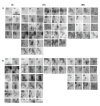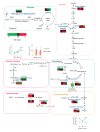Proteome Changes in Stem Tissues of Sunflower Lines Inoculated with Culture Filtrate of Sclerotinia sclerotiorum
- PMID: 34825012
- PMCID: PMC8590719
- DOI: 10.30498/ijb.2021.223625.2722
Proteome Changes in Stem Tissues of Sunflower Lines Inoculated with Culture Filtrate of Sclerotinia sclerotiorum
Abstract
Background: Sclerotinia sclerotiorum (Lib.) de Bary cause a deleterious disease on sunflower plants. Oxalic acid is the main pathogenicity factor of S. sclerotiorum. Two dimensional gel electrophoresis and mass spectrometry have been used in several studies to investigate molecular changes that occur in the plants in response to S. sclerotiorum infection. Comparing responses of resistant and susceptible lines upon pathogen infection provided novel information regarding defense mechanisms against this necrotrophic pathogen.
Objectives: The present study reports proteome changes of partially resistant and susceptible sunflower lines under pathogen's culture filtrate treatment, resulting in the characterization of up- and down- regulated proteins.
Material and methods: Sunflower partially resistant and susceptible lines with two true leaves were exposed to fungus culture filtrate. The stems of treated and untreated plants were sampled at 24, 48 and 72 hours after treatment for two-dimensional electrophoresis. Twenty spots showed more than 1.5-fold change in abundance were subjected to MALDI/TOF-TOF MS for further analysis.
Results: The identified proteins were categorized into several classes including carbohydrate and energy metabolism (25%), cellular metabolic process (15%), stress response (15%), plant cell wall biogenesis (10%), photosynthesis (10%), protein metabolism (10%), unknown function (10%) and redox homeostasis (5%).
Conclusions: Our proteomic investigation demonstrates an increase in the expression of proteins only in partially resistant line, such as proteins involved in carbohydrate metabolism and plant defense responses (malate dehydrogenase and peroxidase), metabolic process (adenosine kinase), regulating cell redox homeostasis (disulfide isomerase) and lignin biosynthetic process (laccase). Moreover, the expression of pyrroline-5-carboxylate reductase, involved in proline biosynthesis, was significantly changed in both sunflower lines in response to pathogen culture filtrate. Proteins which were only up-regulated in the partially resistant lines might have a significant role in mediating the defense against Sclerotinia and could be considered for enhancing resistance against this devastating pathogen.
Keywords: 2-DE; Biotic stress; Sunflower; Tolerance; Sclerotinia.
Copyright: © 2021 The Author(s); Published by Iranian Journal of Biotechnology.
Figures




References
-
- Godoy G, Steadman JR, Dickman MB, Dam R. Use of mutants to demonstrate the role of oxalic acid in pathogenicity of Sclerotinia sclerotiorum on Phaseolus vulgaris. Physiol Mol Plant Pathol. 1990;37(3):179–191. doi: 10.1016/0885-5765(90)90010-U. - DOI
-
- Xiao X, Xie J, Cheng J, Li G, Yi X, Jiang D, et al. Novel secretory protein Ss-Caf1 of the plant-pathogenic fungus Sclerotinia sclerotiorum is required for host penetration and normal sclerotial development. Mol Plant Microbe Interact. 2014;27(1):40–55. doi: 10.1094/MPMI-05-13-0145-R. - DOI - PubMed
-
- Dutton MV, Evans CS. Oxalate production by fungi: its role in pathogenicity and ecology in the soil environment. Can J Microbiol. 1996;42(9):881–895. doi: 10.1139/m96-114. - DOI
LinkOut - more resources
Full Text Sources
